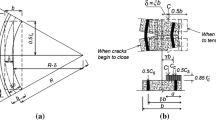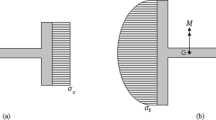Abstract
This study investigates the ability of a finite element model based on curved shell element formulation in predicting nonlinear behavior of planar RC structural walls, identifying the strengths and limitations of this modeling approach. For this purpose, a parametric validation is conducted in addition to verification of the model simulation against experimental results of several wall specimens tested in literature. The effects of variations in total length, thickness, shear-span ratio, axial load ratio, confinement, as well as the horizontal and vertical reinforcement ratios are investigated at both global and local levels. For scrutinizing the global response, lateral load versus total, flexural and shear deformation predictions are used. For local response, sensitivity of the stress and strain distributions throughout the length and height of the wall models to the parameters noted above is evaluated. The capabilities and deficiencies of the modelling approach are discussed in detail in light of the numerical versus experimental as well as parametric verifications. The model is found to be able to predict most of the experimentally observed failure mechanisms of rectangular walls including global out-of-plane instability under in-plane loading, concrete crushing at the base, diagonal tension and diagonal compression as well as sliding shear. The model is not able to represent bar buckling, bar fracture and the potential subsequent secondary failure modes such as instability of the compression boundary zone due to progressive asymmetric concrete crushing at the base. The parametric study indicated sensitivity of the model response to the variation of the parameters known to be influential on the nonlinear response of planar RC walls.
























Similar content being viewed by others
References
Alarcon C, Hube M, de la Llera J (2014) Effect of axial loads in the seismic behavior of reinforced concrete walls with unconfined wall boundaries. Eng Struct 73:13–23
Almeida JP, Prodan O, Tarquini D, Beyer K (2017) Influence of lap splices on the deformation capacity of RC walls. I: database assembly, recent experimental data, and findings for model development. J Struct Eng 143:04017156
Beattie GJ (2004) Design of slender precast concrete wall panels—experimental testing. BRANZ Ltd, Judgeford, New Zealand, BRANZ study report SR 129
Belarbi A, Hsu TT (1994) Constitutive laws of concrete in tension and reinforcing bars stiffened by concrete. ACI Struct J 91:465–474
Brueggen BL, French CE, Sritharan S (2017) T-shaped RC structural walls subjected to multidirectional loading: test results and design recommendations. J Struct Eng 143:04017040
Chang G, Mander JB (1994) Seismic energy based fatigue damage analysis of bridge columns: part I-evaluation of seismic capacity. National Center for Earthquake Engineering Research, Buffalo
Dashti F (2017) Out-of-plane instability of rectangular reinforced concrete walls under in-plane loading. Ph.D. Thesis, Department of Civil and Natural Resources Engineering, University of Canterbury
Dashti F, Dhakal R, Pampanin S (2014a) Numerical simulation of shear wall failure mechanisms. Paper presented at the 2014 NZSEE conference, Auckland, New Zealand
Dashti F, Dhakal RP, Pampanin S (2014b) Simulation of out-of-plane instability in rectangular RC structural walls. Paper presented at the second European conference on earthquake engineering and seismology, Istanbul, Turkey, Aug. 25–29, 2014
Dashti F, Dhakal RP, Pampanin S (2014c) Comparative in-plane pushover response of a typical RC rectangular wall designed by different standards. Earthq Struct 7:667–689
Dashti F, Dhakal RP, Pampanin S (2017) Numerical modeling of rectangular reinforced concrete structural walls. J Struct Eng 143:04017031. https://doi.org/10.1061/(asce)st.1943-541x.0001729
Dashti F, Dhakal RP, Pampanin S (2018a) Evolution of out-of-plane deformation and subsequent instability in rectangular RC walls under in-plane cyclic loading: experimental observation. Earthquake Eng Struct Dyn 47:2944-2964. https://doi.org/10.1002/eqe.3115
Dashti F, Dhakal RP, Pampanin S (2018b) Validation of a numerical model for prediction of out-of-plane instability in ductile structural walls under concentric in-plane cyclic loading. J Struct Eng 144:04018039. https://doi.org/10.1061/(asce)st.1943-541x.0002013
Dashti F, Dhakal RP, Pampanin S (2018c) Blind prediction of in-plane and out-of-plane responses for a thin singly reinforced concrete flanged wall specimen. Bull Earthq Eng 16:427–458. https://doi.org/10.1007/s10518-017-0211-x
Dashti F, Dhakal RP, Pampanin S (2018d) Inelastic strain gradients in reinforced concrete structural walls. Paper presented at the 16th European conference on earthquake engineering, Thessaloniki, Greece
Dashti F, Dhakal R, Pampanin S (2018e) Local vs global instability of ductile structural walls. Paper presented at the 2018 NZSEE conference, Auckland, New Zealand
Dazio A, Beyer K, Bachmann H (2009) Quasi-static cyclic tests and plastic hinge analysis of RC structural walls. Eng Struct 31:1556–1571
Diana T (2011) Finite element analysis user’s manual—release 9.4.4, 9.4.4 edn. TNO DIANA
Fischinger M, Kante P, Isakovic T (2017) Shake-table response of a coupled RC wall with thin T-shaped piers. J Struct Eng 143:04017004
Goodsir WJ (1985) The design of coupled frame-wall structures for seismic actions. University of Canterbury, Christchurch
Haro AG, Kowalsky M, Chai YH, Lucier GW (2018) Boundary elements of special reinforced concrete walls tested under different loading paths. Earthq Spectra. https://doi.org/10.1193/081617eqs160m
Herrick CK, Kowalsky MJ (2016) Out-of-plane buckling of ductile reinforced structural walls due to in-plane loads. J Struct Eng. https://doi.org/10.1061/(asce)st.1943-541x.0001660
Johnson B (2010) Anchorage detailing effects on lateral deformation components of R/C shear walls. Master Thesis, University of Minnesota
Kolozvari K, Wallace JW (2016) Practical nonlinear modeling of reinforced concrete structural walls. J Struct Eng 142:G4016001
Kolozvari K, Arteta CA, Fischinger M, Gavridou S, Hube M, Isakovic T, Lowes L, Orakcal K, Vásquez J, Wallace JW (2018) Comparative Study of State-of-the-Art Macroscopic Models for Planar Reinforced Concrete Walls. ACI Struct J. https://doi.org/10.14359/51710835
Kolozvari K, Biscombe L, Dashti F, Dhakal R, Gogus A, Gullu MF, Henry R, Massone L, Orakcal K, Rojas F, Shegay A, Wallace J (2019) State-of-the-art in Nonlinear Finite Element Modeling of Reinforced Concrete Walls. Eng Struct (in press)
Lu Y, Henry RS, Gultom R, Ma QT (2016) Cyclic testing of reinforced concrete walls with distributed minimum vertical reinforcement. J Struct Eng 143:04016225
Menegotto M, Pinto P (1973) Method of analysis for cyclically loaded reinforced concrete plane frames including changes in geometry and non-elastic behavior of elements under combined normal force and bending. In: IABSE symposium on the resistance and ultimate deformability of structures acted on by well-defined repeated loads, Lisbon. Association internationale des ponts et charpentes
Mindlin RD (1951) Influence of rotary inertia and shear on flexural motions of isotropic, elastic plates. J Appl Mech 18:31–38
Oesterle R, Fiorato A, Johal L, Carpenter J, Russell H, Corley W (1976) Earthquake resistant structural walls: tests of isolated walls. Research and Development Construction Technology Laboratories, Portland Cement Association, Skokie
Orakcal K, Wallace JW (2006) Flexural modeling of reinforced concrete walls-experimental verification. ACI Struct J 103:196
Parra PF (2016) Stability of reinforced concrete wall boundaries. University of California, Berkeley
Parra PF, Moehle JP (2017) Stability of slender wall boundaries subjected to earthquake loading. ACI Struct J 114:1627–1636
Reissner E (1945) The effect of transverse shear deformation on the bending of elastic plates. J Appl Mech 12:69–77
Rosso A, Almeida J, Beyer K (2015) Stability of thin reinforced concrete walls under cyclic loads: state-of-the-art and new experimental findings. Bull Earthq Eng. https://doi.org/10.1007/s10518-015-9827-x
Rosso A, Jiménez-Roa LA, de Almeida JP, Zuniga APG, Blandón CA, Bonett RL, Beyer K (2017a) Cyclic tensile-compressive tests on thin concrete boundary elements with a single layer of reinforcement prone to out-of-plane instability. Bull Earthq Eng. https://doi.org/10.1007/s10518-017-0228-1
Rosso A, Jiménez L, Almeida J, Beyer K (2017b) Experimental campaign on thin RC columns prone to out-of-plane instability: numerical simulation using shell element models. In: VIII Congreso Nacional de Ingeniería Sísmica, Barranquilla, Colombia
Sanada Y, Yamamoto N, Ichinose T, Takahashi S, Tani M, Fukuyama H (2017) Flexure mechanism and deformation at bending-compression failure of RC structural walls. J Struct Eng 144:04017204
Scolari M (2017) Implementation of PARC_CL 2.0 crack model for reinforced concrete members subjected to cyclic and dynamic loading. University of Parma, Parma
Shegay AV, Motter CJ, Elwood KJ, Henry RS, Lehman DE, Lowes LN (2018) Impact of axial load on the seismic response of rectangular walls. J Struct Eng 144:04018124
Tarquini D, Almeida JP, Beyer K (2017) Influence of lap splices on the deformation capacity of RC walls II: shell element simulation and equivalent uniaxial model. J Struct Eng 143:04017157
Terzioglu T, Orakcal K, Massone LM (2018) Cyclic lateral load behavior of squat reinforced concrete walls. Eng Struct 160:147–160
Thomsen JH IV, Wallace JW (1995) Displacement-based design of reinforced concrete structural walls: an experimental investigation of walls with rectangular and T-shaped cross-sections. Department of Civil and Environmental Engineering, Clarkson University, Potsdam
Tran TA, Wallace JW (2015) Cyclic testing of moderate-aspect-ratio reinforced concrete structural walls. ACI Struct J 112:653
Vallenas JM, Bertero VV, Popov EP (1979) Hysteretic behaviour of reinforced concrete structural walls. Earthquake Engineering Research Center, University of California, Berkeley
Vecchio FJ, Collins MP (1986) The modified compression-field theory for reinforced concrete elements subjected to shear. ACI J Proc 83:219–231
Welt TS, Massone LM, LaFave JM, Lehman DE, McCabe SL, Polanco P (2016) Confinement behavior of rectangular reinforced concrete prisms simulating wall boundary elements. J Struct Eng 143:04016204
Acknowledgements
The authors wish to acknowledge the financial support provided by the Ministry of Business, Innovation, and Employment (MBIE) and the Quake Centre at the University of Canterbury to conduct this research.
Author information
Authors and Affiliations
Corresponding author
Additional information
Publisher's Note
Springer Nature remains neutral with regard to jurisdictional claims in published maps and institutional affiliations.
Rights and permissions
About this article
Cite this article
Dashti, F., Dhakal, R.P. & Pampanin, S. A parametric investigation on applicability of the curved shell finite element model to nonlinear response prediction of planar RC walls. Bull Earthquake Eng 17, 6515–6546 (2019). https://doi.org/10.1007/s10518-019-00582-8
Received:
Accepted:
Published:
Issue Date:
DOI: https://doi.org/10.1007/s10518-019-00582-8




